Introduction to Innovative Pest Management
In the quest to maintain a healthy and comfortable living environment, pest management plays a crucial role. Pests not only cause damage to property but can also pose health risks to humans and pets. Traditionally, pest control has relied heavily on chemical solutions, which, while effective, can have negative impacts on the environment and human health. Fortunately, advancements in technology and a growing awareness of sustainable practices have led to innovative solutions that offer effective pest management without the drawbacks of conventional methods.
Biological Control Methods
Biological control is an eco-friendly approach that involves using natural predators to manage pest populations. This method is particularly effective in gardens and agricultural settings where maintaining ecological balance is essential. For instance, ladybugs are introduced to control aphid populations, and parasitic wasps are used to target caterpillars. Biological control not only reduces the need for chemical pesticides but also supports biodiversity.
Several studies have shown that biological control can be as effective as chemical methods when implemented correctly. For example, a study published in the Journal of Applied Ecology found that introducing natural predators reduced pest populations by up to 70% in certain crops. This method is not only sustainable but also cost-effective in the long run, as it reduces the need for repeated chemical applications.
- Promotes ecological balance
- Reduces chemical usage
- Cost-effective in the long term
Integrated Pest Management (IPM)
Integrated Pest Management (IPM) is a holistic approach that combines multiple strategies to manage pests effectively. It involves monitoring pest populations, using preventive measures, and applying targeted treatments only when necessary. IPM emphasizes the use of non-chemical methods first, reserving chemical interventions as a last resort.
This approach is highly customizable and can be adapted to various environments, from residential homes to large agricultural fields. According to the Environmental Protection Agency (EPA), IPM can reduce pesticide use by up to 90% while maintaining pest control efficacy. IPM strategies include habitat manipulation, biological control, and mechanical controls like traps and barriers.
- Reduces reliance on chemicals
- Customizable to different environments
- Focuses on long-term prevention
Technological Advancements in Pest Control
Technology has revolutionized pest management by providing innovative tools and techniques. One such advancement is the use of smart traps equipped with sensors and cameras to monitor and capture pests. These traps can send alerts to homeowners or pest control professionals when pests are detected, allowing for timely intervention.
Another technological innovation is the use of drones for pest surveillance in large agricultural fields. Drones equipped with thermal cameras can quickly identify pest hotspots, enabling targeted treatments. Additionally, ultrasonic devices that emit high-frequency sounds are being used to repel rodents and insects without harming them.
These technological solutions not only enhance the efficiency of pest management but also reduce the need for widespread chemical applications, aligning with sustainable practices.
- Smart traps with sensors
- Drones for pest surveillance
- Ultrasonic devices for repelling pests
Conclusion: Embracing Sustainable Pest Management
As we move towards a more sustainable future, adopting innovative pest management solutions is essential. Biological control, Integrated Pest Management, and technological advancements offer effective alternatives to traditional chemical methods. These solutions not only protect our homes and gardens but also safeguard our health and the environment.
By embracing these innovative approaches, homeowners and agricultural professionals can achieve effective pest control while minimizing the ecological footprint. As awareness and technology continue to advance, the future of pest management looks promising, offering safer and more sustainable solutions for everyone.




Leave a Reply